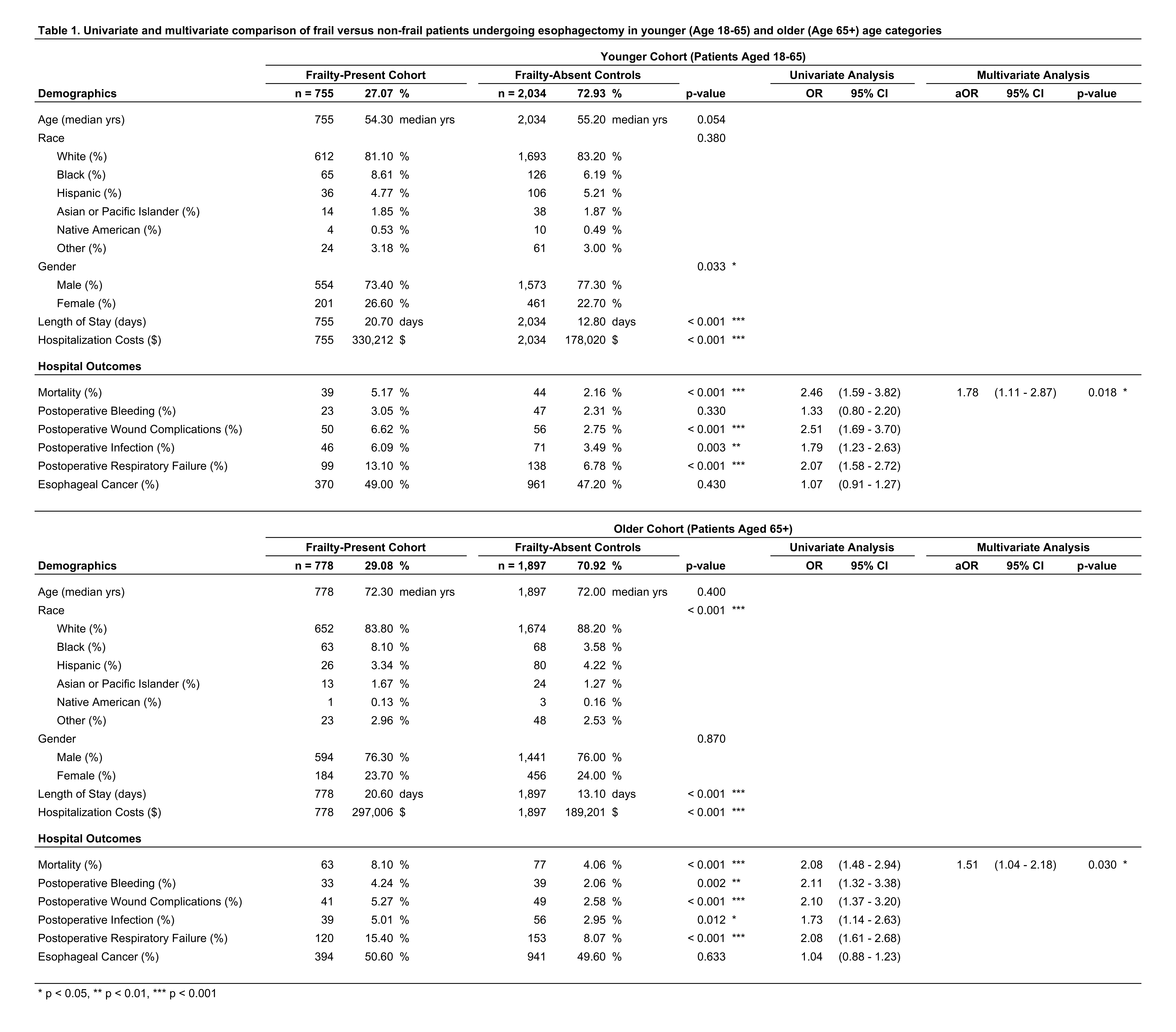FRAILTY IS AN INDEPENDENT RISK FACTOR OF ADVERSE POSTOPERATIVE OUTCOMES IN PATIENTS UNDERGOING ESOPHAGECTOMY: ANALYSIS OF 2011-2017 US HOSPITALS
David U. Lee*, Gregory H. Fan, Raffi Karagozian
Tufts Medical Center, Boston, MA
Background & Aims: Frailty is an established prognostic indicator of poor postoperative outcomes. Since esophagectomies are indicated for esophageal malignancies and esophageal perforations that require surgery, we systematically evaluated the impact of frailty on post-esophagectomy outcomes using a national registry of hospitalized patients.
Method: The 2011-2017 National inpatient sample was used to identify patients who underwent partial or total esophagectomy, who were then divided into younger (age 18-65) and older (age 65+) categories. Each group was then stratified by frailty as defined by Johns Hopkins ACG-frailty defining diagnostic indicators expressed as a composite binary variable. The endpoints included mortality, length of stay, hospitalization costs, and postoperative complications.
Results: Of the esophagectomy cases, 2789 were younger (18-65) and 2675 were older (65+). In the younger category, 755 were frail and 2034 were not frail. There was no difference between frail and non-frail cohorts in terms of age (54.3 vs 55.2 p=0.054) but the frail cohort was more likely to be female (26.6 vs 22.7% p=0.03). Mortality was higher in the frail cohort (5.17 vs 2.16% p<0.01, OR 2.46 95%CI 1.59-3.82), as were LOS (20.7 vs 12.8d p<0.01) and hospitalization costs ($330,212 vs $178,020 p<0.01). In terms of complications, the frail cohort had higher rates of wound complications (6.62 vs 2.75% p<0.01, OR 2.51 95%CI 1.69-3.70), infection (6.09 vs 3.49% p<0.01, OR 1.79 95%CI 1.23-2.63), and respiratory failure (13.1 vs 6.78% p<0.01, OR 2.07 95%CI 1.58-2.72). However, there was no difference in bleeding (3.05 vs 2.31% p=0.33, OR 1.33 95%CI 0.80-2.20). Multivariate model showed frailty was associated with mortality (p=0.02 aOR 1.78 95%CI 1.11-2.87). In the older category, 778 were with frailty and 1897 were without frailty. Between the two cohorts, there was no difference in age (72.3 vs 72y p=0.4) and gender (female: 23.7 vs 24% p=0.87). Mortality was higher in the frail cohort (8.10 vs 4.06% p<0.01, OR 2.08 95%CI 1.48-2.94), as were LOS (20.6 vs 13.1d p<0.01) and hospitalization costs ($297,006 vs $189,201 p<0.01). In terms of complications, the frail cohort had higher rates of bleeding (4.24 vs 2.06% p<0.01, OR 2.11 95%CI 1.32-3.38), wound complications (5.27 vs 2.58% p<0.01, OR 2.10 95%CI 1.37-3.20), infection (5.01 vs 2.95% p=0.01, OR 1.73 95%CI 1.14-2.63), and respiratory failure (15.4 vs 8.07% p<0.01, OR 2.08 95%CI 1.61-2.68). Multivariate model showed that frailty was associated with mortality (p=0.03 aOR 1.51 95%CI 1.04-2.18).
Conclusion: This study shows that frailty is associated with postoperative mortality and complications in patients undergoing esophagectomy. These patients should be provided an analysis of postoperative risks prior to surgery, followed by postoperative care tailored to identifying/treating the observed complications.
This figure demonstrates the multivariate model evaluating the effect of frailty on postoperative mortality in younger (18-65) and older (65+) patients undergoing esophagectomy
This table demonstrates the univariate and multivariate comparison of frail versus non-frail patients undergoing esophagectomy in younger (18-65) and older (65+) categories
Back to 2021 Abstracts
